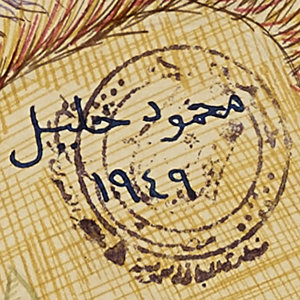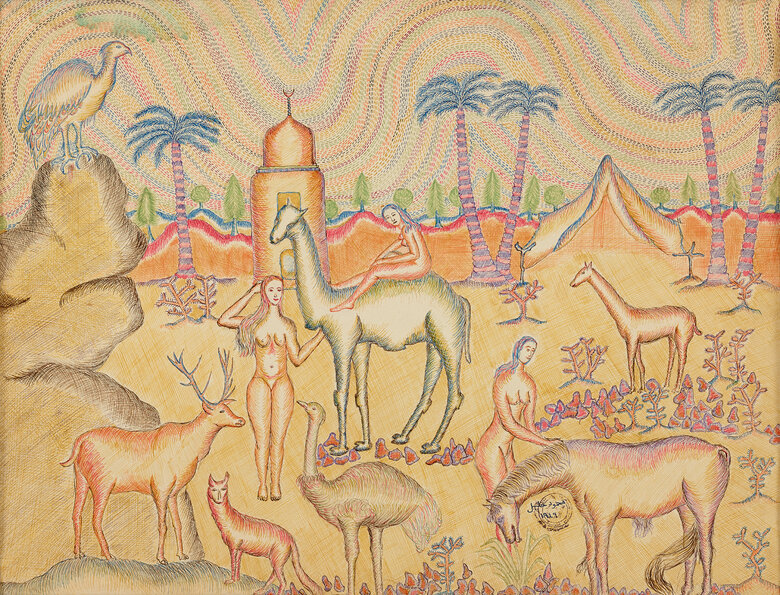Written by Arthur Debsi Born in 1929, Mahmoud Khalil was a shy, and complex person, who early showed a strong passion for literature, and familiarized himself with poetry during his teenage years....


MAHMOUD KHALIL, Egypt (1929 - 1955)
Bio
Written by Arthur Debsi
Born in 1929, Mahmoud Khalil was a shy, and complex person, who early showed a strong passion for literature, and familiarized himself with poetry during his teenage years. Khalil initially studied philosophy under existentialist Egyptian philosopher Abdel Rahman Badawi (1917-2002), and frequented Egyptian writer Mahmud Ahmad Taymur (1894-1973). At that time, the European presence was deeply rooted in the artistic, and cultural fields in Egypt, especially at the École des Beaux-Arts in Cairo, where Western academia was taught, and promoted. Yet, in the second half of the 1940s, some collectives of artists shaped to elaborate innovative artistic conceptions against academia, such as the Contemporary Art Group (Jama’at al-Fann al-Mu’asir). Founded in 1946, the group included Samir Rafi (1928-2004), Abdel Hadi El Gazzar (1925-1966), and Hamed Nada (1924-1990), who were all thinking of creating an original art, which would impose itself against classical art: ‘The purpose of contemporary art runs contrary to the aims of those superficial arts that disregard the secret of life and the secret of our relationships within life’[1]. In their program, the artists intended to celebrate the uniqueness of the Egyptian identity, and local culture. Through a symbolic plastic language, they also wanted to denounce the social, and political issues, which were ongoing in their country.
The tendencies for art of young Mahmoud Khalil caught the attention of Egyptian painter Hussein Youssef Amin (1904-1984), one of the founding members of the Contemporary Art Group. A a matter of fact, the later encouraged Khalil to refine his style, while keeping his peculiar personality[2]. In 1946, Khalil would officially join the Contemporary Art Group, when he exhibited with the other artists at their very first exhibition at the Lycée français in Cairo[3].
In the first stage of his artistic journey, Mahmoud Khalil showed how he liked to combine both art, and literature in his oeuvre. Hence, most of the scenes in the artworks, that he produced, look more like illustrations than actual paintings. Through his work, Mahmoud Khalil immerses the spectator in enigmatic places, as seen in the early piece entitled Navire du Désert (Desert Boat), and executed in 1949. Part of the Dalloul Art Foundation’s collection, this work on paper reveals a joyful scene, where naked women are located in the desert, and surrounded by animals. This is a seminal example, which demonstrates the specific technique of the artist, based on harmony between forms, and colors. Here, Mahmoud Khalil suggested the heat of the desert through a palette of bright colors, that he applied with delicacy, and precision. He also gave luminosity to the scene by leaving few blank spaces within some elements such as the camel, and the horse in the foreground. The fineness of the drawing is also noticeable, with a particular attention paid to details, like in the face features of the characters. With a vivid, yet controlled gesture, Khalil traced straight, and curved lines; which gives a spontaneous aspect to the scene. Moreover, the eye of the viewer is captivated by the dynamic rhythm of the composition, that the artist rendered by covering the sky with small dots in order to create intense vibrations in the background.
The oeuvre of Mahmoud Khalil could be related to various artistic references, resulting from different analyses. In Navire du Désert (Desert Boat), Mahmoud Khalil fulfilled the entire space of the composition, and generated depth by superimposing the elements. The lack of a one-point perspective, and the decorative aspect of Mahmoud Khalil’s colorful works, led Lebanese writer, and art critic Aimé Azar, to make a visual comparison with the Persian miniature, in his book La Peinture moderne en Égypte, published in 1961[4]. On the other hand, the plastic treatment, and the themes, that Khalil often chose to execute, could also recall the naïve art movement, dated from the very beginning of the 20th century. Mahmoud Khalil was highly inspired by subjects from the popular life, especially in the countryside, that he contemplated either in Egypt, or in Sudan, where he had lived for few years. Here, in Navire du Désert (Desert Boat), the artist depicted a dreamlike world, painting the trunks of the palm-trees in pink, and the camel in a greenish color. Furthermore, the iconography, which includes naked women, with animals; symbolically refer to primitiveness, namely the original state of humanity, which was not affected by modernity[5]. In parallel, the rich vegetation evokes a lost paradise, that Mahmoud Khalil connected with the Egyptian countryside.
Discreet member of the Contemporary Art Group, Mahmoud Khalil however remains an important figure of the elaboration of the modern art movement in Egypt. The artistic production, that he left behind after a short life-time, truly corresponds to a pivotal period, when a generation of young Egyptian artists broke off with Western academism. One of their intentions was to give art a local authenticity, that Mahmoud Khalil sought in the scenes of popular life in Egypt, through a very sensitive approach.
Mahmoud Khalil passed away in 1955.
[1] Contemporary Art Group declaration, from transcript published by Husayn Yusuf Amin in ‘Abd al-Hadi al-Jazzar: Fannan al-Thawra’, al-Majalla, no.124 (April 1967); pp.79-80. Translated from Arabic by Sarah Dorman in Lenssen, Anneka, A. Rogers, Sarah, and Shabout, Nada. Modern Art in the Arab World, Primary Documents. New York, USA: The Museum of Modern Art, 2018. [P.114]
[2] Azar Aimé. La Peinture Moderne En Egypte. Caire, Egypt: Editions Nouvelles, 1961. [P.136]
[3] Naef, Silvia. A La Recherche D'une modernité Arabe L'évolution Des Arts Plastiques En Egypte, Au Liban Et En Irak. Genève, Switzerland: Slatkine Reprints, 1996. [P.93]
[4] Azar Aimé. La Peinture Moderne En Egypte. Caire, Egypt: Editions Nouvelles, 1961. [P.136]
[5] Universalis, Encyclopædia. “PRIMITIVISME, Arts.” Encyclopædia Universalis. Accessed April 23, 2021. https://www.universalis.fr/encyclopedie/primitivisme-arts/.
Sources
Abaza, Mona, and Sherwet Shafei. Twentieth-Century Egyptian Art: the Private Collection of Sherwet Shafei. Cairo, Egypt: American University in Cairo Press, 2011.
Azar Aimé. La Peinture Moderne En Egypte. Caire, Egypt: Editions Nouvelles, 1961.
Bardaouil, Sam, and Fellrath, Till. Art Et Liberté, Rupture, War and Surrealism in Egypt (1938-1948), [Exhibition Catalogue, ‘Art Et Liberté, Rupture, Guerre Et Surréalisme En Égypte (1938-1948)’. Paris, Centre Georges Pompidou, October 19th 2016 – January 16th 2017]. Paris, France: Skira, 2016.
Boutros, Nabil, and Al-Kharrat, Edouard. Contemporary Art Group, Cairo 1946, [Exhibition catalogue, ‘Contemporary Art Group’, Dubai, Karim Francis Gallery, Art Dubai 2018]. Dubai, UAE: Karim Francis Gallery, 2018.
Eigner, Saeb. Art of the Middle-East, Modern and Contemporary Art of the Arab World and Iran. London, UK: Merell Publishers Limited, 2011.
Karnouk, Liliane. Modern Egyptian Art, 1920-2003. Cairo, New York, Egypt, USA: The American University in Cairo Press, 2005.
Lenssen, Anneka, A. Rogers, Sarah, and Shabout, Nada. Modern Art in the Arab World, Primary Documents. New York, USA: The Museum of Modern Art, 2018.
Naef, Silvia. A La Recherche D'une modernité Arabe L'évolution Des Arts Plastiques En Egypte, Au Liban Et En Irak. Genève, Switzerland: Slatkine Reprints, 1996.
CV
Selected Solo Exhibitions
1954
Exhibition at Amitiés Françaises club, Cairo, Egypt
Selected Group Exhibitions
2022
Contemporary Views, Almasar Gallery, Cairo, Egypt
2021
Contemporary Views XIV, Al-Masar Gallery for Contemporary Art, Cairo, Egypt
2019
Contemporary Views XII, Al-Masar Gallery for Contemporary Art, Cairo, Egypt
2018
Contemporary Views XI, Al-Masar Gallery for Contemporary Art, Cairo, Egypt
Art et Liberté, Rupture, War and Surrealism in Egypt (1938-1948), Moderna Museet, Stockholm, Sweden
Art et Liberté, Rupture, War and Surrealism in Egypt (1938-1948), Tate Liverpool, Liverpool, United Kingdom
2017
Art et Liberté, Rupture, War and Surrealism in Egypt (1938-1948), Kunstsammlung Nordrhein-Westfalen,Düsseldorf,Germany
Art et Liberté, Rupture, War and Surrealism in Egypt (1938-1948), Museo Nacional Centro de Arte Reina Sofia, Madrid, Spain
2016
The Contemporary Art Group (1946), Al-Masar Gallery, Cairo, Egypt
Art et Liberté, Rupture, guerre et surréalisme en Égypte (1938-1948), Centre Pompidou, Paris, France
2010
Remembered Late Artist Hussein Youssef Amin, Founder of the Group of Contemporary Art, Al-Masar Gallery for Contemporary Art, Cairo, Egypt
1952
The 26th Venice Biennial, Venice, Italy
1948
Exposition de l’Art Contemporain, Service de la Jeunesse, Cairo, Egypt
1946
Foyer d’Art du Lycée Français, Cairo, Egypt
Affiliations and Memberships
1946
The Contemporary Art Group
Collections
The Museum of Modern Egyptian Art, Cairo, Egypt
The Ramzi and Saeda Dalloul Art Foundation, Beirut, Lebanon
Press
Egypt’s National Post Authority issues commemorative stamp for Mohamed Mahmoud Khalil Museum - EgyptToday.pdf
فنان تشكيلي ... محمد محمود خليل.pdf
MAHMOUD KHALIL Artwork
Become a Member
Join us in our endless discovery of modern and contemporary Arab art
Become a Member
Get updates from DAF
Follow Artists
Save your favourite Artworks
Share your perspectives on Artworks
Be part of our community
It's Free!
We value your privacy
TermsCookiesPrivacy Policies
Become a Member
Get updates from DAF
Follow Artists
Save your favourite Artworks
Share your perspectives on Artworks
Be part of our community
It's Free!
We value your privacy
TermsCookiesPrivacy Policies
Become a Member
Get updates from DAF
Follow Artists
Save your favourite Artworks
Share your perspectives on Artworks
Be part of our community
It's Free!
We value your privacy
TermsCookiesPrivacy Policies
Welcome to the Dalloul Art Foundation
Thank you for joining our community
If you have entered your email to become a member of the Dalloul Art Foundation, please click the button below to confirm your email and agree to our Terms, Cookie & Privacy policies.
We value your privacy, see how
Become a Member
Get updates from DAF
Follow Artists
Save your favourite Artworks
Share your perspectives on Artworks
Be part of our community
It's Free!
We value your privacy
TermsCookiesPrivacy Policies




